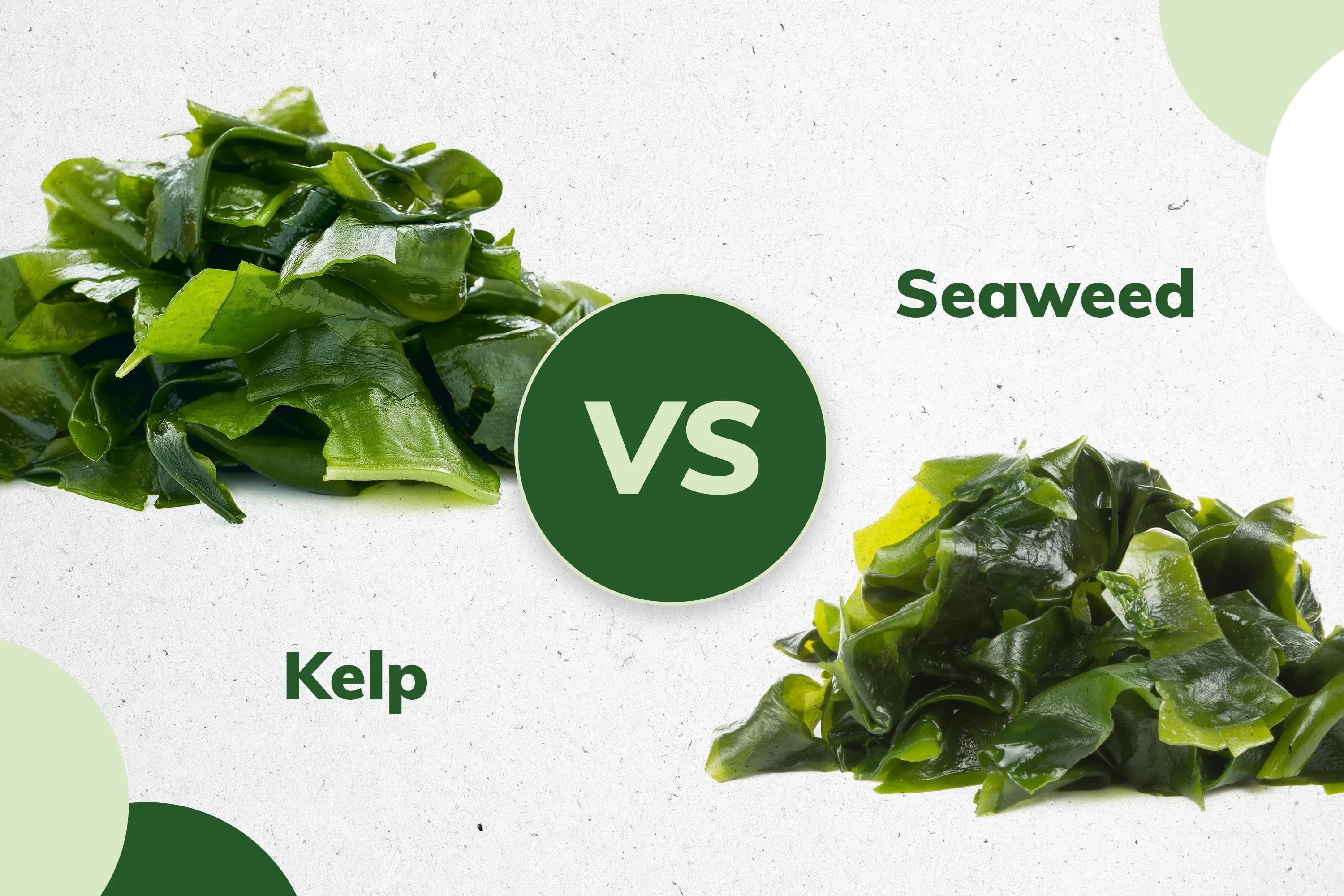Kelp and seaweed might seem the same, but they differ in many ways. For people who are knowledgeable often compare kelp vs seaweed especially when it comes to choosing marine supplements. You may also wonder which one is better. Then explore with us till the end.
In this article, we’ll explore kelp vs seaweed and their key differences, from size to color to potential health benefits. But before we get into the differences between kelp and seaweed, we’ll need to understand exactly what they are. So, let’s dig a little deeper.
Table of Contents
- What is Kelp?
- What is Seaweed?
- Kelp vs Seaweed: Color
- Kelp vs Seaweed: Size
- Kelp vs Seaweed: Potential Health Benefits
- Can You Eat Kelp and Seaweed Together?
What is Kelp?
Kelp is a specific subgroup of seaweed that is known as the largest type of seaweed. It generally grows in nutrient-rich cool waters such as the North Pacific Ocean. It has brown, long, leaf-like blades and also has sturdy but flexible stems.
The largest seaweed species, giant kelp, can grow up to 60 meters in length and is found predominantly in the North Pacific Ocean. Other types of seaweed can float but kelp fixes to a specific spot. Kelp forests are a vital habitat for marine life. Many coastal communities eat kelp as a staple food ingredient in soups, salads, sushi rolls, and stews.

What is Seaweed?
Seaweed is an overarching term used to describe marine macroalgae, a kind of large algae that grows in water. However, kelp is the largest subgroup of seaweed. That means all kelps are seaweed but all seaweeds aren’t kelp.
There are more than ten thousand different seaweed species that grow underwater and absorb nutrients from water rather than soil, unlike land plants we’re familiar with. However, like land trees and plants seaweeds also absorb sunlight for their process of photosynthesis. Photosynthesis is a biological process by which green plants and certain organisms make food and energy to thrive with the help of light.
Kelp vs Seaweed: Color
A big differentiator between kelp and seaweed is their colors. Kelp plants are mainly brown, with shades ranging from pale tan to deep brown. Some plants are tinged with deep green.
Since seaweed encompasses many different species, it has a wide range of colors, and this is how botanists classify seaweed. The color classes are green, red, and brown. Kelp is the brown category of seaweed.
Kelp vs Seaweed: Size
Kelp is known as the largest subtype species in the entire seaweed family. For instance, bull and bladder kelp grow up to 150 feet in length. At this length, they weigh quite high.
In contrast, seaweed sizes are as varied as their species range. They may range from just a few inches to over 150 feet and more.
Kelp vs Seaweed: Potential Health Benefits
Both kelp and seaweed are edible and offer many different potential health benefits. Kelp is more plant-like algae in comparison to other types of seaweeds. For this reason, many botanists think that kelp may contain more nutrients for human bodies than others.
Kelp is densely packed with many important vitamins. It contains a significant amount of iodine, which is vital for good thyroid health. In addition, kelp is rich in calcium content which can provide teeth and bone support.
Kelp is also very high in antioxidants. Antioxidants are molecules that can help cells protect from damage caused by oxidative stress. Studies suggest that kelp may help reduce fat absorption and may help combat obesity. It can also improve heart health and blood glucose levels as well.
Seaweed includes a vast range of marine algae species filled with potential nutritional benefits. For instance, some species contain significant amounts of prebiotic fiber which is important for gut flora health.
Seaweed may help boost the immune system and also may help stimulate the production of antioxidants inside the human body, which in turn help fight free radicals that can cause several chronic health conditions. Free radicals are unstable oxygen-containing molecules that cause large chain reactions in the body and damage cells, tissues, and even organs.
Can You Eat Kelp and Seaweed Together?
Yes, kelp and seaweed can be eaten together. They both offer a number of health benefits. However, it is always best to discuss with a certified naturopath or herbal practitioner prior to using them together. Here are some benefits of kelp and seaweed:
- Nutritional powerhouses
- May help with reducing inflammation
- May help support thyroid health
- May help support reproductive health
- May help promote healthy weight
- May act as a natural diuretic
- May help lower the risk of chronic health conditions
- May help strengthen immune defenses
Final words
Many people wonder whether kelp and seaweed are the same thing. Kelp and seaweed are not the same thing. Seaweed is an overarching term that refers to more than ten thousand marine species, while kelp is the largest seaweed subtype species.




Share:
Ashwagandha vs L-Theanine
Wasabi for Memory Support: Top 4 Benefits